Introduction to Cheese Making
2 Cheese Families
The objectives in the early stages of cheese making are to: (1) obtain the optimum cheese composition with respect to moisture, acidity (pH), fat, protein, and minerals (especially calcium); (2) establish the correct structure of the cheese at the microscopic level; and (3) establish the optimum microflora. For ripened cheeses, a fourth objective is to optimize ripening conditions. Many of the variations in initial make procedures are different means to control the rate and extent of acid development, and the rate and extent of moisture release. These establish the composition and structure required to optimize texture and flavour. Grouped according to texture and basic manufacturing procedures, seven cheese families are described below and summarized in Table 3.1. Table 3.2 contains composition data for some common cheese varieties.
Cheese families are described in this section under five headings, namely, varieties, type of coagulation, pH or acidity control, moisture control and curing. Other technological characteristics of cheese are listed at the end of this chapter.
Please note that while these categories are helpful to classify most cheese in technological groups, the categories cannot be applied rigidly. For examples: (1) Pasta Filata varieties vary widely in composition, manufacturing techniques, and degree of ripening, so they don’t fit any category well; and (2) the manufacture of Cheshire types is similar to Cheddar up to the point of draining, but after that their high acid development is similar to Feta.
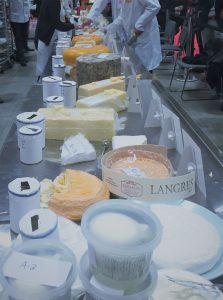
Family 1. Predominantly Acid-coagulated Cheese
In North America, cheese produced by acid coagulation at 30 – 32ºC with little or no added rennet is normally consumed fresh. However, there are many varieties of surface (usually mold) ripened acid-coagulated cheese, such as Valençay, which is native to France. Acid is normally produced via fermentation by lactic cultures, but some acid coagulated cheese is produced by direct acidification with glucono-delta-lactone (GDL) or combinations of cultures and GDL. Other cheese for fresh consumption is made via rennet coagulation (Family 2) and a procedure known as heat-acid precipitation (Family 3).
Varieties: Cottage, Quark, Cream, Valençay, Chaource
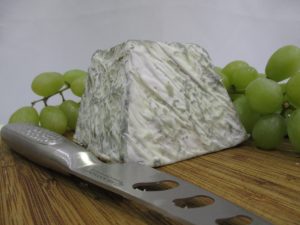
Coagulation: The distinguishing characteristic of these varieties is that coagulation is achieved by acidification to pH 4.6 – 4.8, with little or no coagulating enzyme. Acidification is normally done by lactic acid producing cultures. Many other cheese varieties also use lactic acid producing cultures, but gelation is induced by a coagulating enzyme at pH 6.5 – 6.7, before much acid development has taken place.
pH Control: Optimum pH and the criticality of exact pH control depend on variety. Cottage cheese, after cutting at pH near 4.8, is cooked to 52ºC, which is sufficient to inactivate the culture and prevent further acid development. For some varieties, including cottage, acidity is also reduced by washing the curd before salting.
Moisture Control: Curd moisture, for some acid coagulated varieties, is reduced by syneresis during cooking but remains high, 60 – 70%, in the finished cheese.
Curing: Acid coagulated cheese that is consumed fresh has a shelf life of only 2 – 4 weeks. Ripened fresh cheese may be treated to neutralize acidity and encourage mold growth. For example, Valençay is covered in ash and matured at 80% RH for several weeks.
Family 2. Rennet coagulated Fresh Cheese
In Latin American, Middle Eastern, and some European countries, fresh rennet cheese is produced with little or no culture. Without acid production by lactic acid bacteria, cheese pH remains high and the resulting cheese does not melt when used in a stir fry or other cooked recipes. For reasons of safety and quality, these varieties must be handled with extra attention to sanitation and refrigeration.
Varieties: Queso Blanco, Queso Fresco, Italian fresh cheese, Halloumi
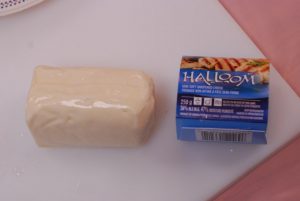
Coagulation: The distinguishing characteristic of rennet coagulated fresh cheese is that little or no culture is used. Coagulation is, therefore, entirely by rennet at the natural pH of milk.
pH Control: The pH is determined by the amount of culture. If no culture is used, the pH remains in the range of 6.5 – 6.7. In some Latin American varieties such as Panela, a small amount of culture may be used to reduce the pH to about 5.8, which reduces the growth of both spoilage (increases shelf life) and pathogenic (increases food safety) microorganisms. Further acidification is inhibited by cooling and salting. Too much acidification below pH 5.8 will produce a meltable cheese which is unsuitable for frying.
Moisture Control: Curd moisture may be reduced by syneresis during agitation and limited acidification, but is still 50 – 70% in the finished cheese. Some recipes include a mild cooking treatment to encourage further syneresis. Some varieties exhibit syneresis after packaging.
Curing: Fresh rennet coagulated cheese has a shelf life of only 2 – 4 weeks.
Family 3. Heat-acid Precipitated Cheese
Varieties: Ricotta (Italy), Channa and Paneer (India)

Coagulation: Coagulation is accomplished by direct acidification of heated milk or blends of whey and milk. High heat treatment of milk (temperatures greater than 75ºC) causes denaturation of the whey proteins. Subsequent acidification of the hot milk coagulates both casein and whey proteins so most of the milk protein is recovered in the cheese.
pH Control: The final acidity (pH) is determined by the amount of acid added. Final pH is normally in the range of 5.3 – 5.8. Any organic acid can be used, but acetic, lactic, and citric acids are most common.
Moisture Control: Moisture can be reduced by holding the curd in the hot curd-whey mixture after coagulation, and by draining and pressing procedures. Moisture is generally high (55 – 80%) due to the high water-holding capacity of whey proteins. High concentrations of whey proteins also decrease cheese meltability and account for the excellent cooking properties of heat-acid precipitated cheese.
Curing: Heat-acid precipitated varieties are normally consumed fresh. Exceptions are some aged heat-acid varieties such as Mizithra (Greek), a type of ricotta cheese, which is cured, dried, and consumed as a grating cheese. It is also possible in some cases to hot pack heat-acid varieties to obtain extended shelf life. For example, the Gryphon Frying cheese described in this manual can be hot packed by extrusion into a sausage-type package.
Family 4. Soft-ripened Cheese
Varieties: Feta, Camembert, Brie, Blue
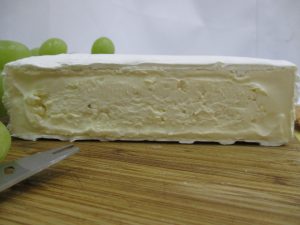
Coagulation: Coagulation is primarily rennet (enzymatic) with three important differences relative to cooked and pressed varieties (Families 5 – 7):
- The amount of lactic acid bacteria inoculum is relatively large and the ripening period before renneting is extended. The results are that acidification has considerable influence on the development of curd structure during setting and demineralization of the curd is increased.
- Cutting is delayed (i.e., setting time increased) to further encourage acidification and demineralization before cutting.
- The curd is cut or broken up into large pieces (1 – 3 cm in diameter).
pH Control: Curd and whey are ‘dipped’ or pumped into forms where the whey drains out and the cheese is formed during several hours at room temperature or warmer. Acid development is influenced by the type of culture, temperature, the time and amount of salting, and of course time before cooling. With some exceptions such as stabilized Brie, the cheese is normally ripened overnight reaching a pH of about 4.3 – 4.6 on the day following manufacture. In the case of Feta, the pH remains low during curing. The pH of mold ripened varieties, especially white mold (Camembert and Brie) increases rapidly during curing (i.e., acidity decreases).
Moisture Control: Syneresis is induced by acid development after forming and by brine or surface salting. Moisture content is typically 45 – 60%.
Curing Time: 2 – 8 weeks.
Family 5. Semi-hard Washed Cheese
Varieties: This is the largest and most diverse group of cheese including Gouda, Edam, Colby, Brick, Montasio, Oka, Muenster and many others.
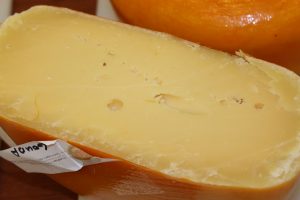
pH Control: The distinguishing feature of these varieties is the practice of washing to remove lactose. Part or all of the whey is removed and replaced with water to leach lactose from the curd. The objective is to limit the amount of lactose to a level that permits sufficient lactic acid development to produce a minimum pH of 5.0 – 5.3, but not enough to ferment and produce cheese pH less than 5.0. Achievement of this minimum pH target is assisted by the buffer capacity of milk, which increases rapidly in the pH range of 5.4 – 4.6. This means that as acidity increases (pH decreases), increasingly higher amounts of acid are required to effect subsequent incremental changes in pH.
Moisture Control: The amount of syneresis is controlled mainly by the temperature and time of cooking and by the temperature of the wash water. Higher temperatures during cooking or washing cause the curd to contract and expel moisture. Also important are the rate of acid development and salting treatments. Washed curd varieties typically have moisture contents of 40 – 50%. With some exceptions, such as part skim Mozzarella, production of a rennet coagulated cheese with a moisture content of more than 40% and minimum pH of 5.0 requires a washing treatment to remove lactose and lactic acid.
Curing: 2 weeks – 9 months.
Family 6. Mesophilic Firm / Hard Cheese Varieties
Firm / hard cheeses (Families 6 and 7) are characterized by lower moisture, with some exceptions such as some Pasta Filata types. Lower moisture, generally less than 40%, permits removal of sufficient lactose by syneresis to avoid the necessity of washing. Low moisture is achieved by high temperature cooking (Family 7) or by controlled fermentation and curd handling (Family 6).
Varieties: Cheddar types and some Pasta Filata types. Cheddar and Pasta Filata manufacture are similar in the early stages. Pasta Filata varieties are distinct in that they are worked and stretched in hot water and brine salted. Cheddar types are salted before hooping and pressing.
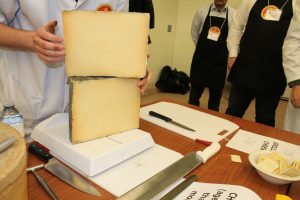
pH Control: The distinguishing feature of these cheese is that acid development is largely controlled by the amount of syneresis during curd ripening (Cheddaring). During curd ripening, the drained curd is allowed to mat, forming slabs of curd that are piled and turned while the culture continues to grow and produce acidity. During this process, lactose is reduced via conversion to lactic acid and by acid induced syneresis. The process of “Cheddaring” is also applied in the manufacture of low moisture Pasta Filata (stretched cheese) varieties, so we prefer to describe it generally as “curd ripening”. Curd ripening techniques have been modified in various ways to facilitate automation.
The objective is to obtain a minimum pH of 5.0 – 5.3 within 1 – 3 days after manufacture. This is similar to the minimum pH target for semi-hard washed cheese varieties. Lactose content is substantially reduced by fermentation with associated moisture loss during curd ripening, salting, and pressing.
Moisture Control: Moisture is controlled by cooking temperature and time, stirring out after draining, curd ripening, amount of culture, and salting treatments. Typical moisture content is 35 – 39% for Cheddar types.
Curing: 1 – 36 months.
Family 7. Hard Cheese: High Temperature

Varieties: Romano, Parmesan, Swiss type
pH Control: Type of culture, time-temperature profile during pressing until cooling, lactose removed by syneresis. There is little acid development before draining.
Moisture Control: Rapid syneresis induced by high renneting temperature and/or high cooking temperature in the range of 46 – 55ºC.
Curing: 1 – 36 months
Syneresis is the contraction of curd to expel water, and is controlled mainly by the temperature and time of cooking, as well as the temperature of the wash water. Syneresis increases with higher temperatures during cooking or washing.
Whey drainage that occurs in forms.

